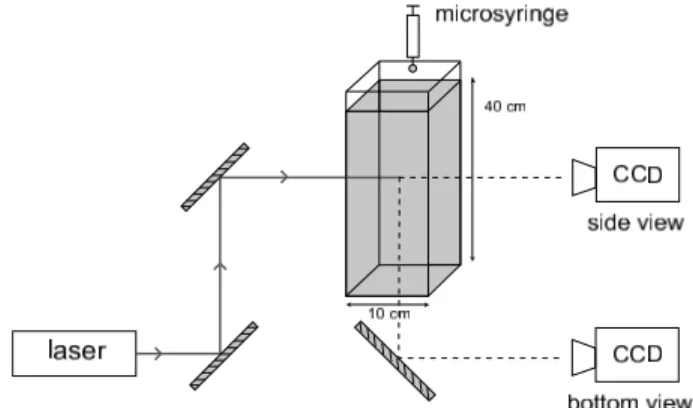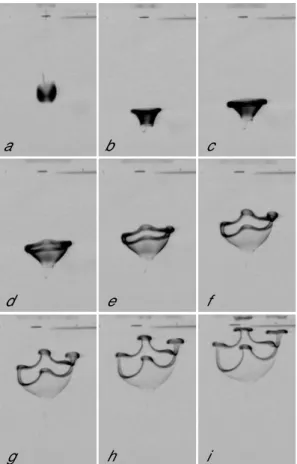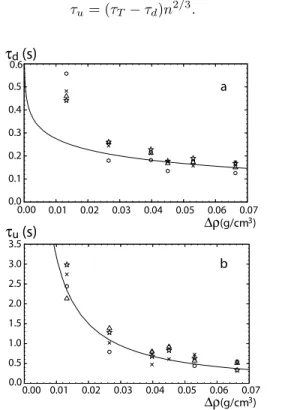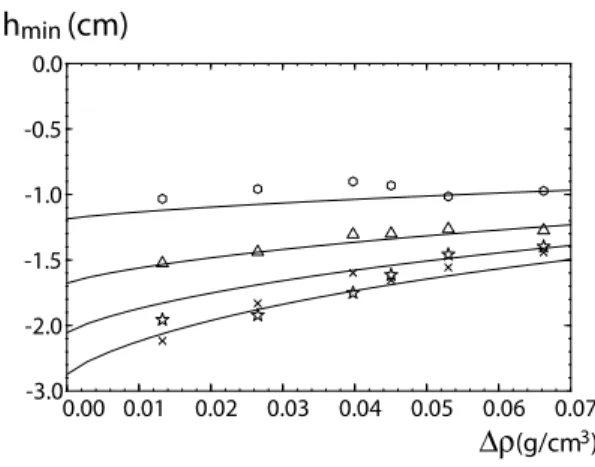HAL Id: hal-00014030
https://hal.archives-ouvertes.fr/hal-00014030
Submitted on 5 Dec 2005
HAL is a multi-disciplinary open access
archive for the deposit and dissemination of
sci-entific research documents, whether they are
pub-lished or not. The documents may come from
teaching and research institutions in France or
abroad, or from public or private research centers.
L’archive ouverte pluridisciplinaire HAL, est
destinée au dépôt et à la diffusion de documents
scientifiques de niveau recherche, publiés ou non,
émanant des établissements d’enseignement et de
recherche français ou étrangers, des laboratoires
publics ou privés.
Fragmentation instability of a liquid drop falling inside a
heavier miscible fluid
Paul Buah-Bassuah, René Rojas, Stefania Residori, Fortunato Arecchi
To cite this version:
Paul Buah-Bassuah, René Rojas, Stefania Residori, Fortunato Arecchi. Fragmentation instability of
a liquid drop falling inside a heavier miscible fluid. Physical Review E : Statistical, Nonlinear, and
Soft Matter Physics, American Physical Society, 2005, 72, pp.067301. �10.1103/PhysRevE.72.067301�.
�hal-00014030�
ccsd-00014030, version 1 - 5 Dec 2005
Institut Non-Lin´eaire de Nice, 1361 Route des Lucioles, 06560 Valbonne, France
2
Phys. Dept., University of Florence and Istituto Nazionale di Ottica Applicata, Largo E. Fermi 6, 50125 Florence, Italy
3
Physics Dept. of the University of Cape Coast, Cape Coast, Ghana (Dated: December 6, 2005)
We report a new type of drop instability, where the density difference between the drop and the solvent is negative. We show that the drop falls inside the solvent down to a minimum height, then fragmentation takes place and secondary droplets rise up to the surface. We have developed a theoretical model that captures the essential of the phenomenon and predicts the correct scalings for the rise-up time and the minimum height.
Pacs: 47.20.-k, 47.20.Bp, 47.32.Cc, 68.05.-n
In the recent years, the physics of liquid drops has been faced with fundamental questions that are becom-ing more and more relevant to practical agricultural and industrial applications [1]. In particular, it seems such fundamental relevance to the dynamics of the drops and the interfaces are ruled by an interfacial surface tension that would be related to the transient presence of ve-locity gradients between the liquid of the drop and the one composing the solvent [2]. Recently, we have demon-strated that when a drop of liquid is deposited over the surface of the same liquid, it falls down inside the sol-vent because the energy associated to its surface tension against air is instantaneously converted into kinetic en-ergy. As a consequence, a very fast fluid injection takes place as the drop touches the surface of the solvent [3, 4]. Universal scaling laws apply, relating the initial velocity transferred at the injected drop to the minimum height at which it stops inside the solvent [4].
FIG. 1: Experimental setup: a solid state laser beam (λ = 532 nm) is shone laterally onto the cell; fluorescence from the drop is recorded by a CCD camera.
It is a well-known phenomenon that, when a liquid drop falls inside a miscible fluid and the density differ-ence between the drop and the solvent ∆ρ, is slightly positive (the drop is heavier than the solvent), then the drop fragments into smaller and smaller droplets [5]. At longer times, the process is washed out by the diffusion of
the drop liquid into the solvent. Recently, we have shown that this hydrodynamical instability is ruled by two non dimensional numbers, the fragmentation number F and the Schmidt number S [6, 8] and displays fractal proper-ties in the statistics of the drop fragments [9].
Here, for the first time we report a set of experiments performed in the case of negative ∆ρ (the drop is lighter than the solvent) and we show that, despite the negative sign of the density difference, the drop does indeed ”fall” inside the solvent, at least initially, when a fast injection takes place because of the almost instantaneous conver-sion of surface energy into kinetic impulconver-sion. When go-ing inwards the solvent, the drop develops a vortex rgo-ing, which expands and falls down until the initial impulsion is dissipated by viscosity. When the ring stops, a new instability takes place that leads to the fragmentation of the ring into smaller droplets. This is a Rayleigh-Taylor instability due to density difference between the drop and the solvent [10]. When ∆ρ > 0 the drop frag-ments continue their descent down inside the solvent, but for ∆ρ < 0, the density difference being negative, an in-version of velocity takes place and the drop fragments rise up towards the surface of the solvent. Thus, the in-stability is equivalent to a Rayleigh-Taylor inin-stability but with the sign of gravity reversed.
The experimental setup, shown in Fig.1, consists of a glass cell with a base of 10x10 cm2
and 40 cm high, mounted on a rigid metallic support. We have studied the behavior of different fluids, namely the solvent was made up of distilled and purified water doped at 10, 15, 25 % Glycerol and the drop was made up of distilled and purified water with a Glycerol concentration varying in between 0 and 25 %. The drop, which is formed at the needle of a high precision Hamilton microsyringe, has a volume V that can be adjusted from 1 to 10 µl, with an accuracy of a few percents. Once formed, the drop is deposited adiabatically, by means of a micrometric trans-lation stage, on the free surface of the solvent. Side and bottom views of the drop inside the solvent are recorded by means of a CCD camera and a solid-state laser illu-mination (λ = 532 nm). The drop is slightly doped with Fluorescein at the purposes of visualization.
2
FIG. 2: Frame assembly, showing the drop injection, the ring formation and the fragment rise-up; a) t = 0.08 s, b) t = 0.20 s, c) t = 0.32 s, d) t = 0.44 s, e) t = 0.56 s, f) t = 0.68 s, g) t = 0.80 s, h) t = 0.92 s, i) t = 1.04 s.
FIG. 3: Drop height h as a function of time for V = 4 µl; ∆ρ = a) 0.01325, b) 0.0265, c) 0.03975 and d) 0.04505 g/cm3
.
at 15 % Glycerol and falling in a 25 % Glycerol doped solvent (∆ρ = 0.053 g/cm3
) is shown in the assembly of Fig.2. The label in each frame corresponds to the time sequencing, where the camera acquisition rate is of 25 frames/sec. We can distinguish the fast injection of
FIG. 4: Drop height h as a function of time for ∆ρ = 0.04505 g/cm3
; V = a) 2, b) 4, c) 6 and d) 8 µl.
the drop, the ring formation, its undulation and the sub-sequent fragmentation into four droplets, then rising-up towards the free surface of the solvent. It is worth to note also that, when the ring expands, it remains attached to a convex membrane. In the case of positive ∆ρ a similar phenomenon was also observed and called turban insta-bility [6]. In that case the curvature of the membrane was in the opposite direction with respect to the present case. Note that the turban instability has been observed also in the case of immiscible fluids [7].
We have performed several experiments by changing the drop volume V and the density difference ∆ρ. For each set of experiments we have recorded several movies following the drop evolution and for each recorded movie we have performed the following processing. We have binarized all the frames by choosing a unique thresh-old intensity and by checking that this one minimizes the discontinuities between each frame and its succes-sive. Then, on each frame we identify the center of mass of the drop, we record its coordinates and we fol-low its trajectory until the drop stops its descent and starts to rise up breaking into fragments. At this point, we choose only one fragment and follow its motion by recording the coordinates of its center of mass. The evo-lution of the longitudinal coordinate, h, of the center of mass is plotted as a function of time for a fixed drop vol-ume, V = 4 µl, and for different ∆ρ (Fig.3) and for a fixed ∆ρ = 0.04505 g/cm3
and different drop volumes, V = 2, 4, 6, 8 µl (Fig.4).
From Fig.3 and 4, we can see that, once the drop has evolved into a vortex ring, it stops at a minimum height, hmin, which is mainly ruled by the initial drop volume, V . On the other hand, when fragmentation takes place, the rise-up time for the secondary droplets mainly de-pends on the density difference, ∆ρ, eventually going to infinity for ∆ρ = 0. At small ∆ρ the rise-up time is very long, while it shortens as ∆ρ increases. The drop injection takes place even in the absence of density
dif-”instantaneous” conversion of the energy associated to surface tension into kinetic energy [3, 4]. Then, viscous dissipation slows down the motion of the drop, which asymptotically reaches the minimum height hmin.
We can describe the dynamical behavior of the drop by writing a simple model that takes into accounts buoyancy and viscous dissipation. The equation of motion reads
dv dt = g∆ρ ρ − γ ν r2v, (1) with r = κ√3
V and γ, κ geometrical factors (γ = 9/2 and κ = 0.62 for a sphere [10]). The initial condition is given by the injection of the drop, v(t = 0) = v0, where v0 comes from the conversion of the drop surface tension into kinetic translational and rotational energy
1 2mv 2 0+ 1 2Iω 2 = 4πσr2 , (2) with I = αmr2
the inertial momentum of the drop and ω = βv0/r its frequency of rotation. If all the rotation is converted into translation, i.e., there is no sliding, then β = 1, otherwise β > 1. We obtain for the initial velocity of the drop
v0= − s
6σ
(1 + αβ2)ρr. (3) By defining the viscous time, τν = r2/γν, we derive from Eq.1 the drop asymptotic velocity, v∞, corresponding to dv/dt = 0,
v∞= ∆ρ
ρ gτν. (4)
Integrating Eq.1 from v = v0to v = 0 we obtain the drop fall-down time, τd, which is the time taken by the drop to stop
τd = τνln(1 − v0 v∞
), (5)
and the minimum height, hmin, reached by the drop be-fore rising-up
hmin= v∞τd+ v0τν. (6) As for the fragment rise-up time τu, if t ≫ τν it is simply given by τu= − hmin v∞ =| v0 v∞ | τν− τd, (7) so that the total elapsed time is τT =| v0/v∞| τν. How-ever, as we can see from Fig.2, the rising-up droplets are
locity to be used here has the same expression as before, Eq.4, but with a volume V /n that is a fraction of the initial one, where n is the number of fragments. If we take into account this correction, we have that
τu= (τT − τd)n
2/3. (8)
FIG. 5: a) Drop fall-down time τdand b) rise-up time τu as
a function of ∆ρ; V = 2 µl circles, V = 4 µl triangles, V = 6 µl stars, V = 8 µl crosses. Lines are the theoretical curves for V = 5 µl.
We show in Fig.5a and Fig.5b, respectively, the drop fall-down time τd, and rise-up time τu, as a function of ∆ρ. From now on, we fix the parameters of the model to αβ2
= 4, γ = 6.67 and κ = 0.56. We plot in Fig.5a the theoretical prediction for τd, as in Eq.5. This curve fits quite well the data for ∆ρ > 0.02 g/cm3
but presents large deviations for lower values of ∆ρ. Indeed, when ∆ρ → 0 the logarithmic divergence does not take into account the dissipation due to the increasing radius of the vortex ring. To include such an effect a more refined model should be developed in order to describe the dy-namics of the ring formation. As for the rise-up time τu, we have plotted in Fig.5b the experimental data by normalizing each value at n2/3, where n is the number of secondary droplets after the fragmentation has taken place. By using the expression in Eq.7, we obtain a good fit of all the data. In Fig.5b we report the curve for V = 5 µl, the curves for the other volumes being close to this one.
The minimum height hmin reached by the drop before rising-up is plotted in Fig.6 as a function of ∆ρ, together with the theoretical curves, Eq.6, for V = 2, 4, 6, 8 µl. We
4 can see that the theoretical curves are in good agreement
with the experimental data. Note that, in the limit of the experimental error, for ∆ρ = 0 we obtain the h ∝ V12
scaling, in agreement with the previously reported law [4].
FIG. 6: Minimum drop height hminas a function of ∆ρ; V =
2 µl circles, V = 4 µl triangles, V = 6 µl stars, V = 8 µl crosses.
FIG. 7: Reduced h − t profiles for the all the experiments in 25% Gly doped solvent.
Finally, we rescale all the h − t data by hmin and τT, and we plot the reduced profiles in Fig.7. We can see that all the drops approximately follow the same evolu-tion law. The early stages of the drop injecevolu-tion are very similar to those observed at ∆ρ = 0: the drop falls very fast inside the solvent and develops a ring. Then, the ring stops because of dissipation of the initial impulsion. At this point, the drop has reached the minimum height hmin, where a velocity reversal occurs and where a new instability takes place leading to the fragmentation of the ring into smaller droplets. Being ∆ρ < 0, the secondary droplets rise-up towards the surface because of buoyancy. This dynamical regime corresponds to the linear portions of the h − t profiles just after hmin. Viscous dissipation slows down the motion of the fragments, but in this
dy-namical regime buoyancy is dominant.
At later times, when fragments approach the surface, we observe deviations from the linear dependence of h vst. Indeed, droplets feel the presence of the boundary and behave as secondary vortex rings, each one colliding over a wall with a longitudinal velocity component [11]. To describe the interaction of the vortex ring with the wall we can replace the wall by the specular image of the vortex ring, this one having opposite circulation with respect to the incoming ring. Because of this interaction, the vortex ring expands and slows down, until, at later times, diffusion takes over the whole process.
In conclusion, we have reported a new type of drop instability, where secondary droplets rise up to the sur-face because of the negative density difference between the drop and the solvent. We have developed a theo-retical model that takes into account the initial conver-sion of surface tenconver-sion into kinetic energy, and we show that buoyancy and viscous dissipation rule the dynamics. Even though simplified, the model captures the essential of the phenomenon and predicts the correct scalings for the rise-up time and the minimum height reached by the drop inside the solvent.
Acknowledgements P.K. Buah-Bassuah gratefully ac-knowledges the International Center for Theoretical Physics of Trieste, Italy, under the TRIL program, for partially supporting his visit at INLN and CNRS France grant. R. Rojas acknowledges financial support from Beca Presidente de la Rep´ublica of the Chilean Govern-ment.
[1] For a review see, e.g., J. Eggers, Rev. Mod. Phys. 69, 865 (1997).
[2] D.J. Korteweg, Arc. Neerl. Sci. Ex. Nat. II, 6 1, (1901); E. Lajeunesse, J. Martin, N. Rakotomalala, D. Salin, Phys. Rev. Lett. 79, 5254 (1997).
[3] A.V. Anilkumar, C.P. Lee and T.G. Wang, Phys. Fluids A 3, 2587 (1991).
[4] S. Residori, E. Pampaloni, P.K. Buah-Bassuah and F.T. Arecchi, Eur. Phys. J. B 15, 331 (2000).
[5] J.J. Thomson and H.F. Newall, Proc. R. Soc. London, 39, 417 (1885).
[6] F.T. Arecchi, P.K. Buah-Bassuah, F. Francini, C. Perez-Garcia, F. Quercioli, Europhys. Lett. 9, 333 (1989). [7] O.N. Boratav, R.B. Pelz and N.J. Zabusky, Phys. Fluids
A 4, 581 (1992).
[8] F.T. Arecchi, P.K. Buah-Bassuah, C. P´erez-Garcia, Eu-rophys. Lett. 15, 429 (1991).
[9] F.T. Arecchi, P.K. Buah-Bassuah, F. Francini, S. Resi-dori, Phys. Rev. E 54, 424 (1996).
[10] D.J. Tritton, Physical Fluid Dynamics, (Clarendon Press, Oxford, second edition 1988).
[11] E. Guyon, Jean-Pierre Hulin and Luc Petit Hydrody-namique Physique, (InterEditions, Editions du CNRS, Paris 1991), p. 323.



